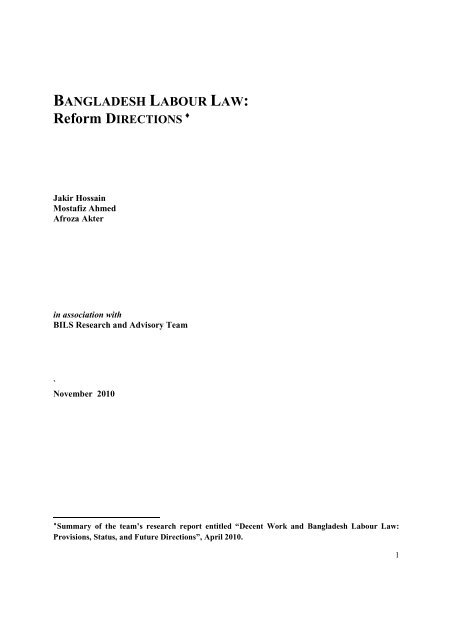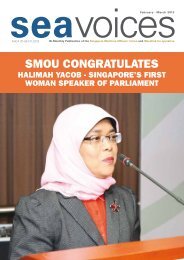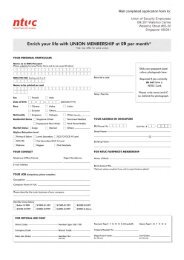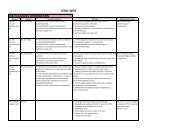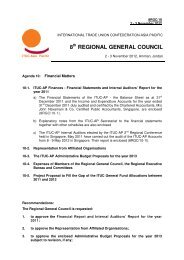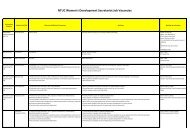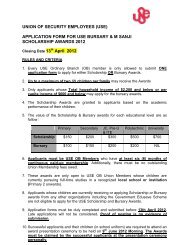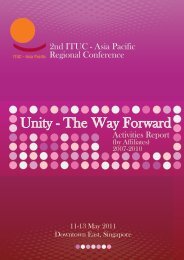BANGLADESH LABOUR LAW: - People Tree Foundation
BANGLADESH LABOUR LAW: - People Tree Foundation
BANGLADESH LABOUR LAW: - People Tree Foundation
You also want an ePaper? Increase the reach of your titles
YUMPU automatically turns print PDFs into web optimized ePapers that Google loves.
<strong>BANGLADESH</strong> <strong>LABOUR</strong> <strong>LAW</strong>:<br />
Reform DIRECTIONS <br />
Jakir Hossain<br />
Mostafiz Ahmed<br />
Afroza Akter<br />
in association with<br />
BILS Research and Advisory Team<br />
`<br />
November 2010<br />
Summary of the team’s research report entitled “Decent Work and Bangladesh Labour Law:<br />
Provisions, Status, and Future Directions”, April 2010.<br />
1
Introduction<br />
This study builds on the current campaign for labour law reform being waged by the trade unions<br />
in Bangladesh. In brief, the study seeks to flesh out the objective and substantive basis for the<br />
reform movement and the needed reform measures to build a just labour relations system in<br />
Bangladesh in the context of the ILO’s Decent Work Agenda (DWA) and the country’s<br />
commitments to the UN’s Millenium Development Goals (MDGs). As defined by the ILO,<br />
decent work is work obtained in conditions of freedom, equality, security and dignity; on the<br />
other hand, the MDGs seek to reduce poverty by half by 2015.<br />
The overall objective of this study then is to propose reform in the labour law for the promotion<br />
of decent work, reducing poverty and ensuring workers’ protection.<br />
Decent work and mass poverty<br />
Bangladesh has integrated the promotion of decent work as part of the “strategic blocks” under<br />
its “Poverty Reduction Strategy Papers” (PRSP). Updated periodically, the PRSP outlines the<br />
broad socio-economic development programs being pursued by the country to meet its MDG<br />
commitments.<br />
As it is, mass poverty has remained the single most critical development-retarding problem in<br />
Bangladesh. The country has reduced poverty by only one percentage point per year during the<br />
1990s. This has allowed a vast and growing number of people to remain unemployed and<br />
underemployed. There are presently over 63 million people below the poverty line, one-third of<br />
whom are trapped in extreme poverty.<br />
The slow pace of MDG fulfilment by Bangladesh is due partly to the pursuit of a narrow growth<br />
only economic strategy, which has, over the years, produced an unequal and even job-less<br />
growth pattern. It has also resulted in a mismatch between sectoral growth and overall labour<br />
absorption in the country (Titumir and Hossain 2005).<br />
For instance, while the contribution of the industrial sector in the GDP has jumped from 29.73<br />
per cent in 2008-09 to 17.31 per cent in 1980-81, nearly 80 per cent of the country’s employed<br />
are still in the huge informal economy where labour standards are hardly observed 1 .<br />
Additionally, the situation in the formal manufacturing sector is far from sanguine. Reports of<br />
worker and human rights violations within and around the different factories are widespread. The<br />
repression of these rights has in fact led to numerous factory protests and blockades in recent<br />
years. Most of the workers in the private manufacturing sector also do not get the various non-<br />
1 However, there is an increasing participation of women in the labour market, growing at a rate of<br />
5.45 per cent annually versus 1.23 per cent for men for the period 2003–06 (although the women<br />
workers account only for one-fourth [12.1 million] of the total labour force of 49.5 million).<br />
2
wage benefits enjoyed by their counterparts in the public sector such as accommodation and<br />
transportation facilities, subsidized meals, maternity protection, medical allowances, bonuses,<br />
pension, provident fund and insurance benefit.<br />
There are other decent work deficits. On wages, the average worker’s compensation is not<br />
sufficient to maintain a minimum standard of living given the inflation rate in the country. There<br />
are also delayed wage payments, long working hour, work discrimination, unsafe working<br />
conditions and poor work environment. Workers are mostly unorganized and face many barriers<br />
in union formation. Consequently, the institution of collective bargaining has, by and large, not<br />
been effective in the country.<br />
Clearly, so much has to be done –by way of economic and labour reforms -- to meet the DWA<br />
and MDG goals in Bangladesh.<br />
In the area of labour reforms, the revised Bangladesh Labour Law of 2006 (BLL), an<br />
amalgamation of the previous 25 labour laws, has weaknesses. Not all workers enjoy the basic<br />
rights spelled out in the law. There are also rampant violations and non-implementation or nonenforcement<br />
of the BLL. Trade unions have long been vocal about the legal shortcomings and<br />
the weak implementation of the laws guaranteeing workers’ rights.<br />
Thus, a critical review of the BLL’s implementation and its shortcomings in terms of coverage<br />
and enforcement is long overdue.<br />
Decent work indicators<br />
This study has adopted the decent work framework in the review of the labour law system of<br />
Bangladesh. As a backgrounder, decent work has four constituent pillars: access to productive<br />
employment and income opportunities; rights at work, particularly with respect to the core labour<br />
standards; systems of social protection; and a voice at work through social dialogue. These are<br />
interdependent and mutually reinforcing (Bell and Kristen 2010).<br />
In this context, the observance of labour rights can be measured in terms of broad and specific<br />
legal provisions or indicators supportive of the key or core areas of labour laws (see Table 1).<br />
The core areas are – (1) employment standards, (2) occupational safety and health, (3) welfare<br />
and social protection, (4) labour relations and social dialogue, and (5) enforcement.<br />
Conduct of the study<br />
This study was undertaken in close consultation and cooperation with the Research and Advisory<br />
Team of the Bangladesh Institute of Labour Studies (BILS). Established in 1995, BILS has been<br />
supporting the work of the 13 cooperating National Trade Union Federations in the areas of<br />
training, research and information sharing. BILS espouses just and worker-friendly policies in<br />
Bangladesh.<br />
3
The study adopted a composite of research methods, which include case studies, interviews with<br />
key informants, focused group discussions (FGDs), brainstorming sessions with the BILS’<br />
advisory team and in-depth reading of the labour laws. A baseline survey of the workers’<br />
appreciation of their rights under the Bangladesh labour system was also conducted among a<br />
sample of workers in the ready-made garments industry (for the formal sector) and construction<br />
industry (for the informal sector). Garments employs 2.4 million workers, 85 per cent of whom<br />
are women; construction has 1.53 million workers, 93 per cent of whom are men. Respondents<br />
for the two industries were selected from the industrial areas of Dhaka and Chittagong.<br />
Table 1. Workers’ Rights Indicators<br />
Key Areas Broad Indicators Specific Legal Provisions (select indicators)<br />
Employment and Appointment letter, employment status, retrenchment,<br />
Contract<br />
dismissal, retirement<br />
Working Hour and Work Working hours, overtime (OT), night work<br />
Time<br />
Wage and Benefits Procedures of wage fixing, regularity and timeliness of wage<br />
and benefit payments, deduction, OT rate, bonuses<br />
Leave and Rest<br />
Weekly rest day, casual leave, festival leave, sick leave,<br />
vacation leave, maternity leave<br />
Elimination of Child Minimum age<br />
Labour<br />
Protection against Forced Labour<br />
Protection against<br />
Discrimination<br />
Occupational<br />
Accident prevention regulations, prevention from workplace<br />
Accidents, Hazards & hazards, safeguards against work-related diseases<br />
Diseases<br />
Employment Standards<br />
Occupational<br />
Safety and<br />
Health<br />
Welfare<br />
and<br />
Social<br />
Protecti<br />
on<br />
Labour Relations<br />
and Social Dialogue<br />
Enforcement<br />
Safety Equipments/<br />
Tools and Facilities<br />
Fire extinguisher & emergency fire exit, protective kits,<br />
helmets, shoes etc.), safety measures<br />
Workplace<br />
Cleanliness, noise, temperature, ventilation, lighting, fumes,<br />
Environment<br />
working space, drinking water, segregated toilet/washroom<br />
General Welfare First-aid appliances, health care & information, canteen,<br />
Provisions<br />
restrooms, accommodation, maternity benefits, etc.<br />
Social Security<br />
Pension, provident fund, gratuity, welfare fund, insurance<br />
Provisions<br />
(accident, life, etc.), compensation (injuries, disabilities), etc.<br />
Freedom of Association Right to form & join unions, union formation rules, freedom to<br />
elect union representatives, protection vs. anti-union acts<br />
Collective Bargaining Rights & scope of bargaining, procedures in bargaining, rights<br />
and Industrial<br />
to strike, conciliation, arbitration, protection vs. interference,<br />
Relations<br />
grievance procedures, protection vs. lock-outs & lay-offs<br />
during strikes, etc.<br />
Tripartite Consultation Tripartite process (formation , composition and scope),<br />
participation in dialogue & consultation in policy formulation<br />
Administrative<br />
Personnel and budget for inspection, inspection process<br />
Capacity<br />
Inspection and<br />
Punishment<br />
Access to Judiciary<br />
Scope of inspections, penalties for violations of laws (payment<br />
of wage, failure to give notice of the accidents, unfair labour<br />
practice, illegal strike or lock-out)<br />
4
Overview of Bangladesh labour laws<br />
The labour law system is more than a century old in Bangladesh. The first labour law was<br />
enacted in the Indian sub-continent during the British period, in 1881. Subsequently, the British<br />
Government introduced several laws concerning different labour issues, e.g., working hour,<br />
employment of children, maternity benefit, trade union activities, wage, etc. The Factories Act<br />
(1881), Workmen's Compensation Act (1923), Trade Unions Act (1926), Trade Disputes Act<br />
(1929), Payment of Wages Act (1936), Maternity Benefit Act (1939), and the Employment of<br />
Children Act (1938) were remarkable labour laws enacted during the British period.<br />
After the separation of the Indian sub-continent in 1947, almost all the laws during the prepartition<br />
period were kept in force with some modifications and amendments, in the form of<br />
administrative rules, by the Pakistan Government. After the independence in 1971, the<br />
Bangladesh government retained the previous laws through the Bangladesh Laws Order<br />
(President's Order No. 48). It also enacted additional laws in response to the changing<br />
circumstances and needs of the working class and the country. In 2006, the country adopted the<br />
revised Bangladesh Labour Law of 2006 or BLL.<br />
The BLL is fairly comprehensive and progressive. The law is a consolidation and updating of<br />
the 25 separate acts. The comprehensive nature of the law can immediately be gleaned from its<br />
coverage -- conditions of service and employment, youth employment, maternity benefit, health<br />
and hygiene, safety, welfare, working hours and leave, wages and payment, workers'<br />
compensation for injury, trade unions and industrial relations, disputes, labour court, workers'<br />
participation in companies profits, regulation of employment and safety of dock workers,<br />
provident funds, apprenticeship, penalty and procedure, administration, inspection, etc.<br />
The BLL is also considered an advance because it removes certain ambiguities in the old and<br />
diverse labour acts and aligns the labour law system with the ILO core conventions. On the<br />
removal of ambiguities, the definition of a “worker” is now very specific. Another example: the<br />
exclusion under the term “wages” of the following items -- expense for housing facilities like<br />
lighting and water supply, employers’ contribution to the provident fund, traveling allowances<br />
and other sums paid to worker that are needed to cover work-related expenses.<br />
The BLL is also an advance because of its wider coverage, for example, workers and staff of<br />
hospitals, nursing homes and even non-governmental organizations are now covered by the law.<br />
Also, certain welfare and social benefits have been improved or instituted, e.g., death benefit<br />
(financial support to family of deceased worker), application of provident fund benefit to all<br />
workers in the private sector, expansion of maternity benefit from 12 to 16 weeks, adoption of<br />
group insurance for establishments with 200 or more workers, and increased employee<br />
compensation for work-related injury, disability and death.<br />
On the ILO core conventions, Bangladesh has ratified the following International Labour<br />
Conventions (ILCs):<br />
5
ILC 29 (Forced Labour),<br />
ILC 87 (Freedom of Association and Protection of the Right to Organize),<br />
ILC 98 (Right to Organize and Collective Bargaining),<br />
ILC 100 (Equal Remuneration),<br />
ILC 105 (Abolition of Forced Labour),<br />
ILC 111 (Discrimination in Employment and Occupation), and<br />
ILC 182 (Elimination of the Worst Forms of Child Labour).<br />
The only core convention not ratified by Bangladesh is ILC 138 (Minimum Age Convention).<br />
However, the BLA provides that the minimum age to work is 14 (although a special clause states<br />
that children between the ages of 12 and 14 may be employed to do “light work” that does not<br />
endanger their health, development and education).<br />
The BLL features the following key provisions:<br />
Employment standards<br />
Salient features of the BLL<br />
<br />
<br />
<br />
An employee or “labour” is defined as any person, including a trainee/probationer,<br />
whether the terms and conditions of his/her employment are expressly written or not, who<br />
is employed directly or through a contractor/agency, for any skilled, unskilled, physical,<br />
technical, business development or clerical job in any establishment or industry.<br />
Workers are classified into six categories:<br />
• Apprentice: A worker who is employed in an establishment as a trainee and<br />
during the period of training he is paid an allowance is called an apprentice.<br />
• Badli: A worker who is employed in an establishment for the period of temporary<br />
absence of a permanent or probationer worker.<br />
• Casual: A worker employed on a casual basis.<br />
• Temporary: A temporary worker in an establishment for work that is basically<br />
temporary in nature and is likely to be finished within a limited period.<br />
• Probationer: A worker provisionally employed in any establishment to fill up a<br />
post of permanent vacancy and his probationer period has not to be completed.<br />
• Permanent: A worker employed with a view to fill up a permanent post or if he<br />
completes satisfactorily his probation period in the establishment.<br />
Appointment letters, ID cards and service books are made mandatory. The law specifies<br />
what information should be included in the appointment letter and in the service book,<br />
and requires the latter to be signed by both the employer and the worker.<br />
6
The law defines who is responsible for payment of wages: employer/owner; chief<br />
executive officer (CEO); manager/person assigned responsible by the company; and the<br />
contractor, in case of worker appointed by the contractor. In case of the failure of the<br />
contractor to pay the wages to the worker, the principal owner shall pay the same and<br />
subsequently it can be adjusted with the accounts of the contractor.<br />
<br />
On job terminations, the employer is required in the case of<br />
• Retrenchment: to give one month’s notice and the equivalent 30-day wages or<br />
gratuity for every year of service if the worker is employed on continuous service<br />
for not less than one year; and<br />
• Discharge: to give financial benefit equivalent to 30-day wages for every<br />
completed year of service by an employee found to have physical or mental<br />
incapacity.<br />
However, the employer is allowed<br />
• Termination simplicitor: to terminate services of worker without explaining any<br />
reason by giving a written notice of 120 days for permanent workers employed in<br />
a monthly basis and 60 days to other workers.<br />
• Misconduct: to dismiss workers without serving prior notice due to worker’s<br />
conviction for any criminal offence, or if the worker is proved guilty of<br />
misconduct, which may be any of the following: willful insubordination (alone or<br />
in combination with others) to any lawful or reasonable order, theft or fraud or<br />
dishonesty, taking or giving bribes, habitual absence without leave for more than<br />
10 days, habitual late attendance, habitual breach of any rule or law applicable to<br />
the establishment, riotous or disorderly behavior, habitual negligence or neglect of<br />
work, frequent repetition of work on which fine can be imposed, resorting to<br />
illegal strike or to go slow or instigating others to do so, and falsifying, tampering<br />
the official document of the employer.<br />
Retirement age for workers employed in any establishment is 57 .<br />
<br />
Work hours are set at eight hours a day, 48 hours a week, with a weekly rest day.<br />
Overtime (OT) work is maximum of two hours a day. OT pay is twice the hourly<br />
remuneration.<br />
<br />
<br />
<br />
Workers are entitled to rest and meal in a day as follows: (i) one hour interval for over six<br />
hours work a day; (ii) half an hour interval for more than five hour work; and (iii) one<br />
hour interval once or half an hour interval twice for more than eight hours work a day.<br />
Workers are entitled to holidays, casual leave, festival leave, annual leave and sick leave.<br />
Every worker has the right to participate in company's profits/benefits.<br />
7
No young worker is permitted to work in any establishment between the hours of 7 p.m.<br />
and 7 am.<br />
No children (under 14 years of age) are allowed to work in any occupation or<br />
establishment. However, a child who has completed 12 years of age is permitted to do<br />
light work not harmful to his health, development and education.<br />
A‘Minimum Wage Board’ is established to determine the minimum rates of wages in<br />
different private sectors, taking into consideration varied criteria: cost of living, standard<br />
of living, cost of production, productivity, price of products, business capability, and<br />
economic and social conditions of the country.<br />
Employers are mandated to observe equal wages for male and female workers for work<br />
of equal nature or value.<br />
Forced labour is prohibited.<br />
Occupational safety and health<br />
<br />
<br />
<br />
<br />
<br />
Establishments are required to put up for every 150 workers one first aid box and one<br />
trained person per first aid box, and an equipped dispensary with a patient-room, doctor<br />
and nursing staff.<br />
Employers are required to take appropriate measures to protect workers from danger and<br />
damage due to fire.<br />
Every establishment is required to be kept clean and free from effluvia arising out of any<br />
drain, privy or other nuisance.<br />
The work room should not be overcrowded and injurious to the health of the workers.<br />
Every establishment should provide pure drinking water, sufficient light and air, and<br />
separate toilets for its male and female workers.<br />
Welfare and social protection<br />
<br />
<br />
Gratuity is defined under the law as separation payment, at least 30 days, for workers<br />
discharged from work and yet have worked not less than 6 months.<br />
Factories are required to have an in-house canteen for every 100 workers.<br />
8
Every establishment/employer is required to form a Provident Fund if three-fourths of its<br />
workers demand it by written application, and a Workers’ Participation Fund and a<br />
Workers’ Welfare Fund for its workers.<br />
Establishments with 200 or more workers should institute a group insurance.<br />
Every employer should provide compensation to its workers for work-related injury,<br />
disability and death.<br />
<br />
Various women’s’ issues are also covered: maternity leave of 16 weeks (8 weeks before<br />
and 8 weeks after child birth), no gender-segregated wage structure, prohibition of any<br />
form of discrimination against women, prohibition of women working between 10:00<br />
p.m. and 6:00 a.m. without consent, prohibition for women handling running or<br />
dangerous machines (unless they are sufficiently trained to operate such machinery),<br />
prohibition for women working under water or underground<br />
Labour relations and social dialogue<br />
<br />
<br />
<br />
<br />
<br />
<br />
Every worker employed in any establishment has the right to form and join a trade union<br />
of their own choice. Trade unions have the right to draw up their own constitution and<br />
rules and to elect their representatives. Also, trade unions have the right to form and join<br />
in a federation and such unions and federations have the right to affiliate with any<br />
international organization and confederation of trade unions.<br />
The trade union is allowed to serve as a collective bargaining agent in any establishment.<br />
In case of industrial disputes, the two sides can seek resolution through negotiation,<br />
followed by conciliation and eventually arbitration if negotiation fails.<br />
The collective bargaining agent is entitled to file a notice of strike (or lockout in the case<br />
of the employer) with a 15-day cooling-off period.<br />
Employers can not recruit new workers during the period of a strike.<br />
Employers are also prohibited in terminating workers in the course of trade union<br />
organizing in the work place.<br />
Enforcement<br />
<br />
Government shall appoint the Director of Labour and “such number” of Additional<br />
Director of Labour, Joint Directors of Labour, Deputy Directors of Labour and Assistant<br />
Directors of Labour as necessary for monitoring workplace activities.<br />
9
The Government shall appoint a Chief Inspectors and requisite number of Deputy Chief<br />
Inspectors, Assistant Chief Inspectors or Inspectors. These officers have the power to<br />
enter, inspect and examine any workplace premises and ascertain the observance of<br />
labour laws.<br />
The Government has the power to establish as many Labour Courts as it considers<br />
necessary. A Labour Court shall consist of a chairman and two members (one<br />
representing employers and the other, the workers).<br />
Findings from the Field<br />
As mentioned, this study sought to examine the weaknesses of the labour law system. To find<br />
out what is obtaining on the ground, the research team administered a baseline survey 2 in the<br />
urbanized and industrialized districts of Dhaka, Chittagong, Narayanganj and Gzipur. The<br />
sample survey targeted worker-respondents in the ready-made garments industry (for the formal<br />
sector) and construction industry (for the informal sector). The survey results were supplemented<br />
by 11 worker FGDs in the different districts, case studies and interviews with key informants in<br />
order to come up with a rounded and objective picture of the state of labour law compliance from<br />
the perspective of the ordinary workers.<br />
From the baseline survey, it appears that more than half of the workers have been working for<br />
not more than three years, with over 40 per cent of the workers in the garments industry<br />
registering a work experience of less than a year. This shows the preference of employers for<br />
the short-term hiring of young workers, particularly in the garments industry. In the construction<br />
industry, most of the workers have longer work years of 3-10 years. However, the prevalence of<br />
three types of employment status -- day labourer, contractual labourer and monthly-based<br />
labourer – indicates a high level of employment informality or flexibility in this industry. In fact,<br />
the overwhelming majority of the construction workers are hired through contractors or subcontractors<br />
without the benefit of any employment contracts. Thus, both the garments and the<br />
construction industries employ flexible (meaning easily replaceable) workers.<br />
In general, the research findings show that workers in both the garment and construction<br />
industries are deprived of many of their rights such as the non-issuance of appointment letters<br />
and identity cards, the non-observance of OSH standards and social security provisions, the<br />
limited space for unionism and collective bargaining, and the weak protection provided by the<br />
labour law enforcement and judicial system. Below is a summary of key research findings:<br />
2 A baseline survey questionnaire developed by LO/FTF and ITUC/AP for its affiliates in the Asia-<br />
Pacific region was adopted by the research team, translated into Bangla language and modified to<br />
suit Bangladesh situation after some pre-testing runs.<br />
10
Appointment letter: A dream to most workers. Though the law has made it mandatory<br />
for employers to provide appointment letter to the workers, a large number of garments<br />
workers are still deprived of appointment letter (45.3%). Although garments employers<br />
often prepare appointment letters (usually two copies: one for employer and another for<br />
global garments buyers), they do not give copies to the workers. In the construction<br />
industry, none of the workers reported receiving any appointment letter.<br />
Oral contract: pervasive Practice. In the absence of written contracts, what prevails in<br />
general is oral contract. Also, a good number (30.2%) of workers do not get identity<br />
cards from their employers.<br />
Dismissal of workers without notice. Over one-fourth (26.4%) of the respondents in the<br />
garments industry affirmed that employers always dismiss workers without any prior<br />
notice. The situation is more or less the same in the construction industry.<br />
8-hour work, OT rules hardly followed. All the garments workers said that they work<br />
more than eight hours daily. Sometimes they work 13-14 hours a day. There are workers<br />
who even work extra five hours of daily OT. About one-third (33.5%) of the garments<br />
workers do not know the OT rate, with 13 per cent of the respondent garments workers<br />
getting less than Tk.10 for every hour of OT work against the minimum Tk.10.80 per<br />
hour OT work. For the construction workers, work hours range at 8-12 hours.<br />
Low wage awareness. More than half (52.4%) of the respondents do not know whether<br />
they are receiving wages according to their grades. A large number (about 40 %) of<br />
respondents in the garments industry also do not know whether the minimum wage is<br />
implemented at their workplaces. More than half (54.7%) of the garments workers and<br />
almost all (98.1%) of the construction workers do not receive pay slip or any other<br />
document concerning the payment of wages and benefits.<br />
Missing workers’ participation in company's benefit. Garments workers are not aware<br />
about any provision regarding workers’ participation in company’s benefit.<br />
Weekly rest day and leaves not observed. Many garments workers do not have the<br />
chance to enjoy weekly rest day. Most workers get festival leave but employers often<br />
impose conditions to enjoy the leave. Legal provisions on casual leave, sick leave and<br />
annual leave are widely violated. Sometimes some employers make wage/salary<br />
deductions for the workers to enjoy weekly rest day, casual leave, sick leave and festival<br />
leave. In the construction industry, most workers do not have the chance to enjoy these<br />
leaves as the compensation policy is simply ‘no work, no pay’.<br />
<br />
Rest periods: irregular. Only 13.2 per cent of the garments workers have admitted that<br />
they enjoy regular rest periods, meaning the majority enjoy this right in a highly irregular<br />
manner. In the construction sector, 49.5 per cent respondents reported that this right is<br />
limited in practice.<br />
11
Child labour: still a reality. Both the garments and construction industries still employ<br />
child workers (below 14 years of age), per observation by 9.9 per cent of worker<br />
respondents in the garments industry and 13.1 per cent in construction. Three<br />
respondents happen to be below 14. The employment of child workers in both the<br />
garments and construction industries is governed by oral contract. The nature of work<br />
given to these child workers are the same as those given to adult workers.<br />
Women discriminated in job placement, increment and promotion. Female garments<br />
workers are not discriminated with regard to wages. But they face discrimination in job<br />
placement, increment and promotion. In the construction industry, females are<br />
discriminated in wages, benefits and other areas.<br />
High occupational risks, low risk information, limited risk prevention. Workers in both<br />
industries face numerous occupational risks and accidents. The most common risks in<br />
garments are the “pricking of finger by needle” followed by “cuts” in hand. In<br />
construction, the most common risk is “falling down from high place.” And yet,<br />
employers usually do not provide information on these occupational risks, as explained<br />
by 43 per cent of worker respondents in the garments industry and 65 per cent in<br />
construction. Majority (61.8 % in garments and 72.1 % in construction) of respondents<br />
said that authorities have not taken any measure to prevent further accidents at their<br />
workplaces. In garments, while some measures are taken, these are not sufficient and<br />
often done before the global buyers’ presence.<br />
Safety facilities: inadequate in garments and absent in construction. In garments<br />
factories, fire extinguishers and emergency stairs are present but are generally inadequate<br />
compared to the number of workers. Some factories do not even have these facilities,<br />
with emergency stairs even kept under lock and key by some employers. Safety<br />
equipments and tools are also not always provided to the workers. A large number (46%)<br />
of respondent do not know whether they are provided safety tools. Many workers also do<br />
not get any risk reduction training. Only 2.8 per cent of the construction workers get<br />
safety tools from the employer.<br />
Unfriendly work place environment. While majority of the respondents said that the<br />
conditions of ventilation, lighting, temperature and humidity are good in their work place,<br />
about one-fourth said that this is not so. In the construction sector, most of the<br />
respondents claimed that the facilities to contain dirt, heat, ventilation, dust, noise,<br />
smoke, humidity and so on are bad or non-existent. Further, in most cases, there is no<br />
safe drinking water.<br />
<br />
Occupational illness, The proportions of workers who said that they have suffered<br />
occupational illness are 18.4 per cent in garments and 29 per cent in construction.<br />
Harassments at the workplace. About 40 per cent of the garments workers and 30 per<br />
cent of the construction workers said that they endure mental harassment (due to verbal<br />
abuse and the likes). More worrisome, more than one-fifth (21.7 %) in the garments<br />
12
industry and a few (8.4 percent) in the construction mentioned that they have<br />
experienced or faced physical harassment and torture. A few respondents (1.9 % in<br />
garments and 0.9 % in construction sectors) also admitted that they were harassed<br />
sexually at their workplaces. All these answers were affirmed by the FDG participants.<br />
<br />
Welfare facilities: available in law only. The BLL enumerates various welfare facilities<br />
like first aid kit, canteen, restroom, day care/children’s room, medical care, separate<br />
place/room for lunch at the workplaces of the workers. However, a large number of the<br />
respondents said that they are not provided with many of these facilities. In the<br />
construction sector, very few (9 %) said that they have first-aid kits; most said that the<br />
other facilities are generally absent.<br />
Violations of maternity and social welfare programs. No factory provides maternity<br />
leave for four months and most factories give maternity leave only without pay.<br />
Participants also report that female workers many times do not want to bear child because<br />
of fear of losing the job. Very few garments factories have introduced provident fund and<br />
gratuity for the workers. Group insurance is also not effective in most of the garments<br />
factories. In construction sector, workers are completely deprived of all these programs.<br />
<br />
<br />
<br />
Garment and construction: generally unorganized. Most of the workers in the garments<br />
and construction industries are not organized. Almost all of the respondents mentioned<br />
that there is no workers’ association in their factory or at the workplace. A few reported<br />
on the existence of workers’ association that are not trade union in nature.<br />
Barriers to TU formation: fear of losing Job, long hours of work. Garments and<br />
construction workers do not join trade unions, as they do not want to lose their jobs.<br />
Workers in both sectors disclosed that their employers would dismiss them from job if<br />
they are found engaged in any sort of activities related to workers’ association. There are<br />
cases where employers send workers suspected of union organizing to police custody.<br />
Also, since workers of these two industries log long hours of work every day, they hardly<br />
have time for trade union activities.<br />
Collective bargaining: limited and informal in nature. Predictably, only 2.8 per cent of<br />
worker respondents in the garments industry and 0.9 per cent in the construction admitted<br />
that they have knowledge or been involved in collective bargaining with their employers.<br />
Moreover, bargaining is of the limited informal type, with garments workers bargaining<br />
with the employers through informal mediators and construction workers with individual<br />
contractors.<br />
Right to strike: widely unrecognized. Only 7.5 per cent of the garments workers and 4.7<br />
per cent workers in the construction said that strikes were conducted at their workplaces.<br />
Workers in both industries perceive that the right to strike is never recognized at their<br />
workplaces, with some employers even punishing workers who go on or participate in<br />
strikes. A significant number of workers even do not know whether they have this right.<br />
13
Limited freedom to express grievances, limited role of TUs and tripartite process. The<br />
opportunity for the workers to express their grievances at the workplace is severely<br />
limited. Disputes raised at the shop floor are solved mainly through informal discussion<br />
in both industries, presumably with the HR departments of the factories. The role of<br />
workers associations and tripartite body were mentioned by only a few garments workers.<br />
Inspection: “fire brigade” approach. Most workers said that they never met any<br />
government officials coming and inspecting their workplaces. Those who have visited<br />
their work places talked only to the employers. Also, inspections take place only after<br />
some accidents have occurred, like the fire brigade taking action after the fire.<br />
<br />
Access to judiciary: low awareness. Very few workers get the opportunity to take legal<br />
measures concerning conflicts with employers. They usually inform the police about such<br />
issue and a few take action through the workers association. A large numbers of workers<br />
(68.4 % in garments and64.5 % in construction) do not know whether they can take legal<br />
measures against their employers.<br />
GAPS and WEAKNESSES in the BLL<br />
From the foregoing research findings, it is clear that there are widespread violations of labour<br />
rights and labour laws in Bangladesh. Can these violations be cured by stricter enforcement?<br />
The answer is yes. But this is not enough because the BLL itself has some weaknesses. Below<br />
is a discussion of major gaps and weaknesses in the BLL identified by research team.<br />
Employment standards<br />
The BLL fails to include a large number of workers -- domestic workers, agriculture workers,<br />
and workers working at schools.<br />
The law has classified workers into several categories. This has given some employers flexibility<br />
to resort to the hiring of non-regular workers (i.e., apprentice, casual, badli, probationer,<br />
temporary) to escape payment of various workers benefits and avoid unionism.<br />
Worker dismissal is terribly easy under the provision on termination simplicitor, where the<br />
employer is not required to give any reason to terminate a worker and the worker is not given<br />
any chance for self-defense. Also, the notice period for the temporary workers in this regard is<br />
quite short.<br />
Getting financial benefit due to termination are quite lengthy too. For retrenchment and<br />
discharge, a worker must show proof of a minimum one-year service.<br />
Workers who resign from their jobs are entitled to certain separation benefits. However, getting<br />
these benefits is bureaucratic. The concerned worker is also asked to give the employer advance<br />
14
notice 60 days, 30 days and 14 days (corresponding to employment status of permanent,<br />
temporary [monthly]).<br />
In cases of serious misconduct, the law allows summary termination without prior notice. This<br />
deprives the worker not only compensation but also and more importantly, the right to due<br />
process or the right to be heard.<br />
The BLL prohibits employers to employ women workers for the period between 10 p.m. to 6<br />
a.m., and yet, relaxes this rule by allowing the same women workers to work if the latter give<br />
their consent.<br />
In the determination of minimum wage, the family size criterion has not been considered. Nor is<br />
the need to balance efficiency and equity. Further, the mandatory wage review of every five<br />
years is too long given the rapid changes in the economy and rising workers’ needs.<br />
The law still lacks clarity as to what items can be deducted from the basic wage, what can not be<br />
deducted and what are the sources (and basis) of any wage deductions.<br />
The calculation of OT pay is not spelled out for piece-rated workers. In the first place, the law<br />
does not provide specific guidelines on the fixing of basic wages for the piece-rated workers.<br />
The BLL recognizes various types of leaves, e.g. weekly holiday, casual leave, festival leave,<br />
medical leave, annual leave, and maternity leave. However, the law is discriminatory in the<br />
sense that the level of leave entitlement is not same for all categories of workers, for example,<br />
some workers like tea-state workers do not enjoy casual leave.<br />
Although the current law extended the maternity leave, this is not enjoyed by the many who are<br />
under short-term hiring arrangements, especially since the law states that a six-month<br />
employment is needed to get maternity leave.<br />
Forced labour is prohibited and yet there are no penal sanctions against this.<br />
On child labour, the prohibition is contradicted by the provision which allows the employment<br />
of children who are 12 years old in works that are supposedly not detrimental to their health and<br />
education.<br />
The law lacks specific provisions on discrimination related to work place facilities, treatment of<br />
non-wage issues (e.g., promotion and placement), and other grounds of discrimination such as<br />
race, religion, ethnic group, etc..<br />
Occupational Safety and Health<br />
The law has no clear provisions on the following:<br />
15
(i) specific weight limit (for load carried by workers in any factory) according to age,<br />
condition and sex;<br />
(ii) ratio of alternative stair as precaution in case of fire and other apparatus against the<br />
number of workers; and<br />
(iii) workers-toilet ratio.<br />
Welfare and Social Protection<br />
The establishment of provident fund is not mandatory. It is dependent on the demand of a prerequisite<br />
number of workers. Group insurance is also dependent on the number of the workers<br />
and the prerequisite number is quite high.<br />
The amount of compensation given to workers due to work-related injury, disability and death is<br />
not adequate for the worker and his/her family. The provision of compensation is also<br />
discriminatory in terms of age of the workers, with an adult worker getting Tk. 1,25,000 for<br />
complete permanent impairment whereas a child/adolescent/young worker gets Tk.10,000 only.<br />
Other aspects of social protection have remained untouched in the labour law of Bangladesh such<br />
as provisions on pension and medical and life insurance for the workers.<br />
Labour Relations and Social Dialogue<br />
A new provision in the law has banned TU offices within the 200 yards of an industry. This<br />
limits, physically, the scope for trade union activities.<br />
The law allows the functioning of three registered trade unions in an establishment or a group of<br />
establishments, and yet an amendment states that workers of Chittagong and Mongla Sea Port<br />
are allowed to form only one trade union at their respective workplaces. Thus, the law is<br />
discriminatory as well as self-contradictory.<br />
The law sets a very stiff requirement in trade union formation -- support of 30 per cent of the<br />
workers in an establishment. For new unions, this is virtually a trade union ban.<br />
The law has also imposed a ban on strikes in some industries, in particular a 3-year ban on<br />
strikes in newly-established industries and industries established for or supported by foreigners.<br />
This collides head-on with ILCs 78 and 98 and Freedom of Association and Collective<br />
Bargaining.<br />
The requirements for a lawful strike are stiff, particularly the requirement of proof of support of<br />
at least 3/4 members of the CBA unit. In situations where the life of the union is at stake (e.g.,<br />
leaders being dismissed from work), such a requirement is a virtual subversion of unionism.<br />
On the other hand, there is no specific provision with respect to protection of workers in lockout<br />
situations, especially if the intention of the employer is to temporarily close down the factory to<br />
destroy the union.<br />
16
There is a 30-day limitation to file appeal before the Labour Court when the Director of Labour<br />
rejects any application to register a trade union. This is relatively short for unions with limited<br />
resources and whose members work long hours daily. There is also time limit in appealing<br />
before the Labour Appellate Tribunal. According to the law, an aggrieved person can appeal the<br />
verdict of the labour court on lay-off, retrenchment, discharge and dismissal within 30 days<br />
The law is not clear on the right of labour leaders and the workers themselves to represent union<br />
members and themselves in the labour courts. The rules of the court are also technical and tend<br />
to favour the financially capable employers.<br />
There are no clear rules on how grievances can be raised at the plant level.<br />
As to disputes elevated outside the plant, the process of dispute settlement is complex, timeconsuming<br />
and expensive for the workers and the unions. There are many stages in the process<br />
and each takes a long time.<br />
The BLL has no express provisions on the principle of “due process”, which should be observed<br />
by employers in disciplinary, suspension and termination cases. Due process means workers<br />
should be given ample opportunity to be informed or notified about the basis of the specific cases<br />
against them, and to defend themselves through a procedure that is fair and objective.<br />
The system of tripartism, tripartite consultations and formation of tripartite bodies requires<br />
clearer rules. For example, the BLL is silent on the tenure of the tripartite members of the Wage<br />
Board and the manner and criteria guiding the selection of the worker’ and employers’<br />
representatives in the Wage Board.<br />
Enforcement<br />
Punishment for labour law violations is not spelled out under the BLL. In some cases, the law is<br />
simply silent like in the case of forced labour prohibition. In other cases, the penalty is<br />
insufficient or meager, for example Tk. 5000 as fine for violation of provisions on maternity<br />
leave, employment of child and adolescent workers, and minimum wage. Still in other cases, the<br />
application of penalty defies logic, for example, imprisonment up to one year for the violation of<br />
minimum wage provision but not in the violation of the laws on maternity and employment of<br />
child and adolescent workers.<br />
In addition, there is a recent amendment weakening the penalties for erring employers – payment<br />
of only Tk. 5000 as fine for the previous punishment of ‘imprisonment up to three months, or<br />
fine up to Tk. 1000, or both’.<br />
As discussed in the research findings, there are also numerous problems related to the system of<br />
labour inspection.<br />
17
As to access to the judiciary, the labour law has a general provision guaranteeing workers’ access<br />
to the judiciary for redress of grievances but is not clear on how such access can be realized, step<br />
by step, at minimum or affordable cost to the workers and their unions.<br />
<strong>LABOUR</strong> REFORMS for<br />
DECENT WORK and INDUSTRIAL DEMOCRACY<br />
The Constitution of Bangladesh, in Article 14, states:<br />
“It should be a fundamental responsibility of the State to emancipate the toiling masses – the<br />
peasants and workers - and backward section of the people from all forms of exploitation”.<br />
The reality is that so much have to be done to make the above constitutional vision of worker<br />
emancipation from all forms of exploitation a reality. Economic reforms are obviously needed to<br />
put Bangladesh on the path of balanced, job-full and inclusive growth process. Political reforms<br />
are also needed to insure that growth is sustained in the framework of a stable democracy.<br />
However, in the area of labour laws and labour relations, the foregoing research findings and<br />
analysis of the Bangladesh labour law system show that urgent labour law reforms are needed.<br />
These reforms should be pursued in the context of the DWA, MDG and the Constitutional<br />
mandate for workers protection against all forms of exploitation. In this connection, the<br />
research team is proposing the<br />
updating of legal provisions in employment standards, health and safety and social<br />
welfare and social protection,<br />
strengthening of legal provisions on trade unionism and collective bargaining, and<br />
enforcement of labour rights.<br />
In particular, the following key reforms are needed:<br />
Align the BLL with international norms, particularly ILC 87 and ILC 98. As a<br />
signatory to many of international conventions and covenants related to worker rights,<br />
Bangladesh should align the BLL with internationally recognized workers’ rights,<br />
particularly those relating to the core ILO conventions. More specifically,<br />
• The BLL should cover all workers without exception. These include the domestic<br />
workers, agricultural workers, school workers and informal workers.<br />
• The right to form unions, especially in the garments industry, should be given widest<br />
space in terms of legal provisions. Some doables:<br />
o Removal of the 30 per cent requirement for trade union registration<br />
o Amendment of the ¾ requirement for a strike to be declared to a simply<br />
majority<br />
o Removal of any strike ban in any industry<br />
18
o Removal of any rules on where to locate trade union offices and all artificial<br />
barriers to union formation.<br />
o Workers should should be given the full freedom to choose their<br />
representatives and form unions without fear of dismissal or harrassment.<br />
o Enactment of laws against unfair labour practices committed by employers,<br />
e.g., dismissal of trade union officers and members, intervention in internal<br />
trade union affairs and so on.<br />
• The right to negotiate and conclude collective bargaining should be expressly<br />
recognized in the law. Some doables:<br />
o Mandatory provision on good-faith bargaining by both sides once a union is<br />
duly registered and recognized as the most representative<br />
o Provisions on how both sides can bargain in the spirit of mutual respect within<br />
certain time lines<br />
Promote coherence in the BLL in the context of DWA, MDG and Constitutional<br />
mandate on protection for all workers against all forms of exploitation. Among others,<br />
this entails –<br />
• Strict regulations on the use of short-term workers, e.g., apprentices (should be for<br />
real learning purposes and not for employment at below minimum wages), casuals,<br />
badly, temporary, probationers and so on.<br />
• Purging the BLL of contradictory provisions, e.g., on enjoyment by workers of<br />
weekly rest day, employment of child labour, and the number of trade unions to be<br />
recognized at the workplace as discussed earlier.<br />
• Elimination of discrimination at the work place by covering non-wage and other<br />
issues such as race, religion, ethnic group, age group etc.<br />
• Removal of obstacles to workers’ entitlements to certain benefits, e.g., in filing claims<br />
for separation benefits on resignation, compensation for work-related injury or<br />
accidents, etc.<br />
• Timelines for the processing of workers’ claims should be subject to the test of<br />
fairness and equity.<br />
• Application of the principle of universality in the development and application of<br />
various social welfare and social protection schemes such as provident fund, group<br />
insurance and so on.<br />
Strengthen enforcement and administration of labour justice. There are major concerns<br />
that should be addressed under this theme such as --<br />
• Removal of termination simplicitor and its replacement with the proviso that serious<br />
misconduct can be a ground for worker dismissal only after the worker is given due<br />
process or the right to be informed, the right to be heard and the right to sort out the<br />
truth through an objective and fair process.<br />
• The due process principle should be enshrined and should apply to all cases of<br />
suspension and termination.<br />
19
• A schedule of progressive (from light to heavy) penalties for erring employers for<br />
various labour standard or labour right violations should be enacted and enforced<br />
strictly.<br />
• The system of labour inspection should be upgraded and should involve the unions in<br />
the development of inspection standards and norms.<br />
• The BLL should be purged of provisions weakening workers’ exercise of their rights<br />
such as work during festivals or doing excessive overtime if they have the so-called<br />
“workers’ consent”, or allowing 12-year olds to work if they have consent and so on.<br />
• Unclear provisions such as estimation of OT rate for piece-rated workers should be<br />
spelled out under the law.<br />
• The maternity law should be reviewed and should not be used as an excuse for hiring<br />
only single or unmarried women on short-term basis.<br />
• The Wage Board and other tripartite bodies should be reconstituted on the basis of<br />
clear criteria in the selection of tripartite representatives, clear mandate on their<br />
powers and functions and their tenure.<br />
• Workers and union representatives should be recognized in the labour courts, which<br />
should conduct their proceedings or hearings in a non-technical manner.<br />
• The Ministry of Labour should spell out how organized and unorganized workers can<br />
seek redress for various grievances in various forums – in the workplace, at the labour<br />
ministry or at the labour court.<br />
20
REFERENCES<br />
Absar, Syeda Sharmin. (2001). “Problems Surrounding Wages: The Ready Made Garments<br />
Sector in Bangladesh, Labour and Management in Development Journal, Vol.2, No.7.<br />
BBS (2009), Gender Statistics of Bangladesh 2008, Bangladesh Bureau of Statistics, Planning<br />
Division.<br />
BBS (2009), Gender Statistics of Bangladesh 2008, Government of Bangladesh.<br />
BBS, Labour Force Survey 2005-06, Government of Bangladesh.<br />
Begum, Nazma. (2002). Women Workers' Status in Bangladesh: A Case of Garment Workers, in<br />
Salauddin, Khaleda; Raushan Jahan and Latifa Akanda (eds) State of Human Rights in<br />
Bangladesh, Dhaka: Women for Women.<br />
BILS. (2007). Construction Sector and its Workers: A Review (Sromokhat Parjalochona:<br />
Prosanga Nirman Shilpo), Dhaka: Bangladesh Institute of Labour Studies.<br />
BILS. (2007). Workers Human Rights in the Construction Sector of Bangladesh, Dhaka:<br />
Bangladesh Institute of Labour Studies.<br />
CPD, (2008). Gender and Trade Liberalisation in Bangladesh. Dhaka: Centre for Policy<br />
Dialogue<br />
GoB (2009), Bangladesh Economic Review 2009, Finance Division, Ministry of Finance,<br />
Government of the <strong>People</strong>’s Republic of Bangladesh<br />
Hossain Jakir and Islam Rabiul. (2008). Minimum Wage for Garments Workers: Implementation<br />
Status and Changes of Workers’ Economic Security), Dhaka: Nari Uddog Kendra and<br />
Unnayan Onneshan.<br />
ILO (1999), Report of the Director-General: Decent Work, International Labour Conference,<br />
87 th Session, Geneva.<br />
ILO, (2005). Hours of Work: From fixed to flexible? Available at<br />
p://wwwhtt.ilo.org/wcmsp5/groups/public/-<br />
dgreports/dcomm/documents/meetingdocument/kd00123.pdf.<br />
Majumder, Protima Paul and Begum Anwara. (2000). “The Gender Imbalances in the Export<br />
Oriented<br />
Garment Industry in Bangladesh,” Gender and Development, Working Paper Series no 12.<br />
21
Mohiuddin, Md. Helal (2004). Globalization led Changes in Livelihood Strategies, Social<br />
Organisation and Rural-Urban Linkage of Women garment Workers in Bangladesh, University<br />
of Manitoba.<br />
Morshed M. Monjur (2007). A Study on Labour Rights Implementation in Readymade Garment<br />
(RMG) Industry in Bangladesh: Bridging the Gap between Theory and Practice.<br />
Murayama, Mayumi. (2006). Globalization and Female Employment in Bangladesh: Readymade<br />
Garments Workers in Post- MFA Era, Retrieved from<br />
http://www.idejetro.jp/English/Publish/Download/jrp/pdf<br />
Okene, V.C. Ovunda. “Curbing State Interference in Workers’ Freedom of Association in<br />
Nigeria”, The International Journal of Not-for-Profit Law, Volume8, Issue4, August 2006,<br />
Retrieved From http://www.icnl.org/KnoWleDge/ijnl/vol8iss4/art_2.htm, on 15 February, 2010.<br />
on 18.October 2009.<br />
Quasem, A.S.M. (2006).Gender Equality Competitiveness and Export Performance in the<br />
Garments Sector in Bangladesh.<br />
Rahman, M, Bhattacharya D and Moazzem K G. ( 2008) Bangladeh Apparel Sector in Post MFA<br />
Era; A study on the Ongoing Restructuring Process, Dhaka: Centre for Policy Dialogue<br />
Titumir R.A.M and J. Hossain, (2005). Lost in the Queue: Employment and Poverty in<br />
Bangladesh, Dhaka: Unnayan Onneshan<br />
22


